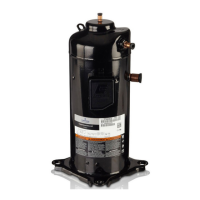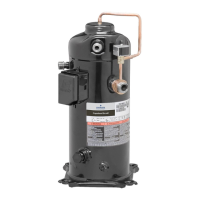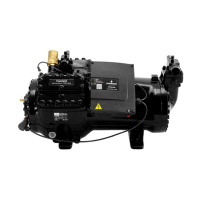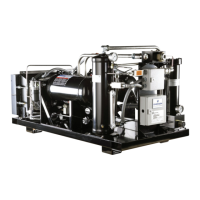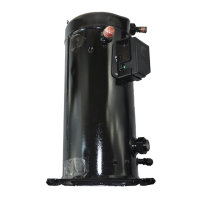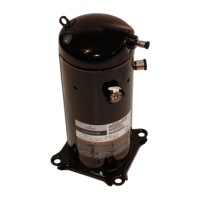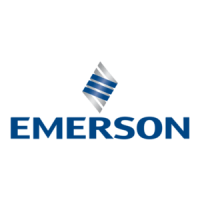
Do you have a question about the Emerson Copeland Discus Series and is the answer not in the manual?
| Frequency | 50/60 Hz |
|---|---|
| Refrigerant | R-22, R-407C, R-134a, R-404A, R-507 |
| Application | Air Conditioning, Refrigeration |
| Stages | Single Stage |
| Cooling Method | Air Cooled, Water Cooled |
| Displacement | Varies with model |
| Voltage | 575 |
| Sound Level | Varies with model |
| Weight | Varies with model |
Explains safety icons used in the manual for hazard communication.
Lists essential safety rules for personnel, equipment, and intended use.
Provides general safety warnings and instructions for handling and operation.
Overview of compressor families, types, and applications.
Explains the purpose and scope of the application guidelines document.
Details the model designation system for compressors.
Details the model designation system for air/water-cooled compressors.
Details the model designation system for suction gas-cooled compressors.
Explains how to interpret compressor nameplate data.
Explains nameplate designations for older DWM Copeland compressor models.
Explains nameplate designations for current Copeland brand compressors.
Covers the scope of applications for the compressors.
Lists compatible refrigerants and oils for compressor operation.
Refers to software for detailed compressor application limits.
Details the various design aspects of the compressors.
Describes the internal and external construction of compressor series.
Details methods of compressor and cylinder head cooling systems.
Explains the concept and benefits of unloaded compressor starts for reduced stress.
Describes mechanical capacity control options available for compressors.
Explains the Demand Cooling accessory kit for low-temperature applications.
Details the DTC valve for low-temperature R22 applications.
Explains lubrication systems for air/water-cooled compressors.
Describes oil pumps used in suction gas-cooled compressors.
Explains how to measure and interpret oil pressure readings.
Details the oil circulation process within the compressor.
Instructions on how to check and maintain the correct oil level.
Recommends oil separators for booster systems.
Specifics for R22 low-temp apps with certain models.
Guidelines for safely handling and moving compressors.
Procedures for checking compressor delivery for correctness and completeness.
Safety precautions for transporting and storing compressors to prevent damage.
Instructions for correctly positioning and securing compressors.
Recommendations for selecting a suitable installation location for compressors.
Details on mounting parts for vibration reduction and shock absorption.
Details pressure safety controls for compressor protection.
Specifies requirements for high-pressure cut-out devices.
Specifies requirements for low-pressure cut-out devices.
Explains the function of internal pressure relief valves.
Details the function and specifications of oil pressure switches.
Lists the maximum permitted operating pressures for compressors.
Provides essential guidelines for proper brazing techniques to prevent contamination.
Advises on the use and minimum opening size of system screens.
General advice before making electrical connections to the compressor.
Guides on wiring single-phase and three-phase motors.
Specifics for single-phase motor electrical connections and components.
General information on three-phase motor connections.
Details for direct-on-line start motor connections.
Explains star-delta motor wiring and voltage interchangeability.
Details for part-winding motor connections and start sequence.
Refers to external wiring diagrams for recommended power and control circuits.
Advises on installing external protection devices like fuses before the compressor.
Details motor protection systems for compressors.
Explains thermal protection for single-phase motors.
Details thermistor protection for three-phase motors.
Covers protection against high discharge temperatures.
Explains the Demand Cooling system for low-temperature applications.
Details oil pressure monitoring and control systems.
Explains the function and wiring of the OPS2 oil pressure switch.
Describes the SENTRONIC oil pressure control system.
Details the ALCO FD 113 ZU oil pressure switch.
Explains the purpose and types of crankcase heaters.
Procedures for performing a leak test on the refrigeration system.
Steps for evacuating the refrigeration system to remove moisture.
Checklist for pre-start checks before system operation.
Guidelines for charging the system with refrigerant.
Instructions for the initial startup of the compressor.
Recommends minimum run time for oil return after start-up.
Information on compatible inverters and frequency ranges for operation.
Procedures for changing refrigerants in the system.
Guidelines for retrofitting to new refrigerant blends.
Advises on periodically re-torquing shut-off valves for leak prevention.
Steps and precautions for replacing a compressor, including accumulator.
Details oil types and handling for HFC refrigerants.
Disclaimer regarding the use of oil additives and potential warranty issues.
Safety warnings for unbrazing system components due to flammable mixtures.
Common lubrication issues and their potential causes.
Explains oil dilution and its effects on compressor operation.
Discusses refrigerant migration and prevention methods.
Identifies causes and effects of low suction superheat.
Explains acid formation, its causes, and how to address it.
Discusses issues related to insufficient compressor cooling.
Explains high discharge temperatures and their symptoms.
Causes of motor burnout from undersized contactors.
Explains motor burnout from bypassed protectors.
Procedures for safely dismantling and disposing of compressors and their contents.
Details on standard compressor connection types and sizes.
